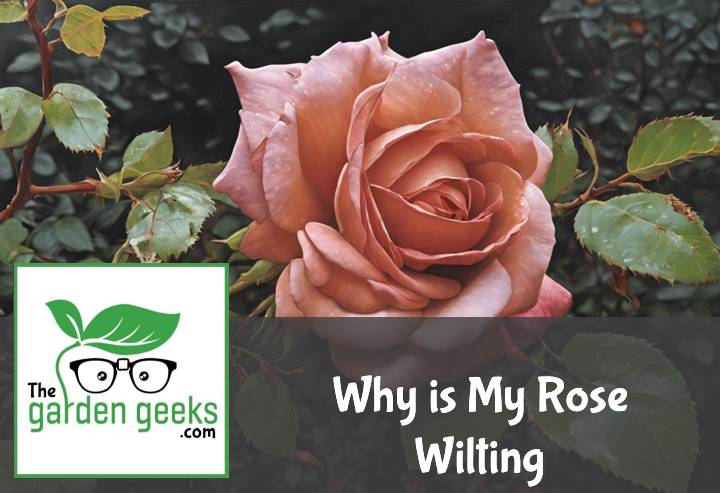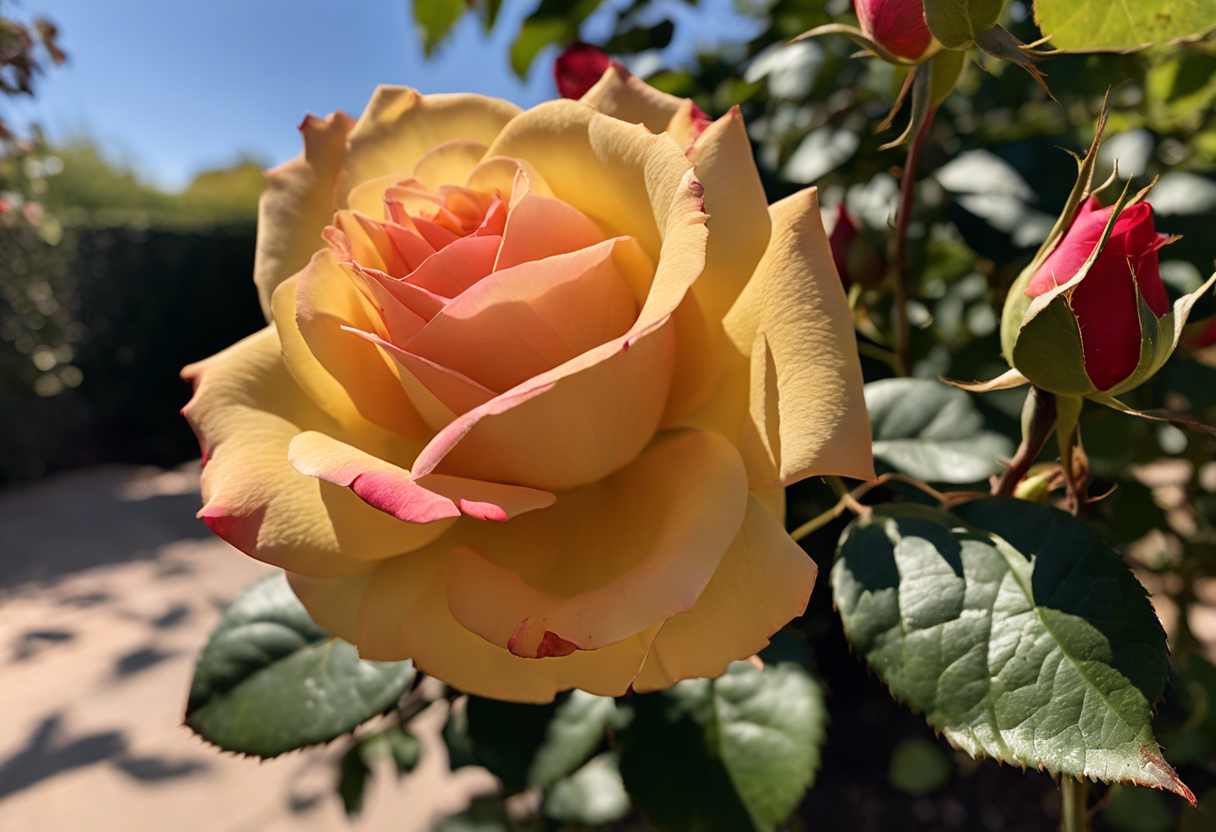Ever found yourself pondering, “Why are my Wilting Roses looking so down in the dumps?” Well, you’re not alone. We’ve all been there, staring at our once vibrant roses now hanging their heads low.
Don’t fret just yet! With a little TLC and some know-how, you can nurse your wilting roses back to health. So buckle up, fellow rose enthusiasts! Let’s dive into the world of reviving wilting roses. Keep reading about ‘Why is My Rose Wilting? (Revive Wilting Roses)’.
Key Takeaways
- Roses wilt due to improper watering, lack of sunlight, poor soil conditions, or disease.
- Overwatering or underwatering can cause wilting. Ensure the soil is moist but not waterlogged.
- Roses need at least six hours of direct sunlight daily.
- Soil should be well-draining and rich in organic matter.
- Diseases like blackspot, powdery mildew, or rose rosette can cause wilting. If infected, treat with appropriate fungicides or consider removing the plant to prevent spread.
Understanding Rose Wilting
When it comes to rose health, wilting is a red flag that your plant is under some serious stress. It’s one of those garden problems that can make any green thumb go pale. But don’t fret, we’re here to help you understand the ins and outs of wilting roses.
What is Rose Wilting?
So, what exactly is rose wilting? Well, it’s when your roses start looking like they’ve lost their mojo. The petals droop, the leaves sag, and the whole plant just seems…well, sad. This isn’t just an aesthetic issue – it’s a sign that your rose isn’t feeling too hot.
Wilting affects the overall health of the plant. When a rose wilts, it’s basically sending out an SOS signal saying “Hey! I’m not okay!” So if you see signs of wilted roses or unhealthy roses in your garden, it’s time to play detective and figure out what’s going wrong.
Causes of Rose Wilting
Now let’s talk about why roses wilt. There are quite a few culprits behind this disheartening phenomenon. Environmental stressors for roses can include extreme temperatures or improper watering effects (yes, there is such a thing as too much love!).
On top of that, certain soil conditions for roses might not be ideal causing them to wilt. And let’s not forget diseases causing wilting – these bad boys can sneak up on your plants without warning! Pests affecting roses are another common cause of wilting. So as you see, there are many factors at play when dealing with wilting roses.
Common Symptoms of a Wilting Rose
When your rose starts to wilt, it’s like watching a drama unfold in slow motion. It’s heartbreaking, but knowing the signs can help you act fast. So let’s dive into the world of wilting roses and their symptoms.
Discoloration and Drying
One telltale sign of a wilting rose is discoloration. You know, when your once vibrant rose starts looking like it’s auditioning for a zombie movie? That’s not good news, folks. This usually happens due to dehydration or lack of nutrients.
But wait, there’s more! Along with color change, drying is another symptom. Your rose might start looking as parched as a desert traveler on a hot day. This is often due to inadequate watering or extreme weather conditions.
Drooping Stems and Leaves
Next up on our list of wilting rose symptoms are drooping stems and leaves. Imagine your rose doing the limbo dance but without any fun involved – that’s what we’re talking about here.
This droopiness is usually caused by overwatering or under-watering (yes, roses can be picky!). It could also be due to diseases that weaken the plant structure. And trust me, this isn’t just an aesthetic issue; it affects the overall health of your beloved roses too!
Bud Failure and Leaf Drop
Last but not least, we have bud failure and leaf drop. If your rose buds are failing faster than my New Year resolutions (ouch!), then you’ve got a problem at hand.
Bud failure often happens due to pests or diseases while leaf drop could be caused by stress factors like temperature changes or poor soil conditions. And these issues don’t just ruin your garden aesthetics; they hit hard on the overall health of your roses too!
Diagnosing the Problem
When your roses start to wilt, it’s like a cry for help. But don’t panic! Wilting roses diagnosis is all about understanding the root cause. It could be overwatering, underwatering, pests and diseases, or even environmental factors. Remember, every rose has its thorn – or in this case, its issue.
Checking for Overwatering or Underwatering
Water is life for roses. But too much or too little can lead to wilting. If your rose leaves are yellow and falling off, you might be dealing with rose overwatering symptoms. On the other hand, if they’re dry and brittle, you’re looking at underwatered roses signs.
It’s a delicate balance and getting it right is crucial for healthy blooms. So remember folks, when it comes to watering roses properly – not too much, not too little!
Identifying Pests and Diseases
Oh boy! Pests and diseases are like uninvited guests at a garden party – they can wreak havoc on your beautiful blooms. Aphids? Blackspot? Powdery mildew? These common culprits can cause serious rose plant problems, leading to wilting.
So keep an eye out for these sneaky invaders when identifying rose issues. And remember – early detection is key in treating diseased roses!
Assessing Environmental Factors
Roses love the sun but too much of anything isn’t good! Excessive sunlight or temperature fluctuations can stress out your plants causing them to wilt.
Remember folks: Roses aren’t just pretty faces; they have needs too! Understanding their sunlight requirements and how temperature affects them will go a long way in preventing those pesky wilting roses from ruining your day.
How to Revive a Wilting Rose
So, your rose is wilting and you’re wondering how to bring it back to life? Don’t fret! We’ve got some rose care tips that’ll help you revive your wilting rose in no time.
Adjusting Watering Techniques
First things first, let’s talk about watering. You see, roses are pretty picky when it comes to hydration. Too much water and they drown, too little and they dry up. So what’s the secret sauce? It’s all about balance.
Overwatering can cause root rot, which leads to wilting. If you think you’ve been overzealous with the watering can, hold off for a bit. Let the soil dry out before giving your rose another drink.
On the flip side, underwatering can also lead to wilting roses. Roses need consistent moisture to thrive. If the top inch of soil feels dry, it’s time for a drink.
Treating Pests and Diseases
Next up on our rose plant revival mission is dealing with pests and diseases. These little buggers can wreak havoc on your roses causing them to wilt.
Common culprits include aphids and blackspot fungus. For aphids, try a gentle insecticidal soap or neem oil spray. Blackspot fungus? A fungicide should do the trick.
Remember though, prevention is better than cure! Regularly check your roses for signs of pests or disease so you can nip any problems in the bud (pun intended).
Modifying Environmental Conditions
Lastly, let’s chat about environmental conditions – light exposure and temperature play a big role in how well your rose grows.
Roses love sunlight but not too much heat – around 6 hours of morning sun is perfect. If your rose isn’t getting enough light or is baking in scorching afternoon sun, consider moving it to a more suitable spot.
Temperature-wise, roses prefer cooler conditions. If temperatures are consistently high, your rose may start to wilt. Try providing some shade during the hottest part of the day.
So there you have it! With these tips, you’ll be able to rejuvenate your wilted rose in no time. Happy gardening!
Preventive Measures for Future Wilting
When it comes to rose care prevention, nipping the problem in the bud (pun intended!) is key. By focusing on preventing rose wilting and adopting proper rose plant care practices, you can keep your roses blooming beautifully. Plus, with early detection in roses, you can spot any signs of trouble before they escalate.
Proper Plant Care Practices
So, what’s the secret sauce to prevent future wilting? Well, it’s all about giving your roses what they need. For starters, get your rose watering practices right. Roses are like Goldilocks – not too much water, not too little, but just right!
Next up is sunlight. Remember, roses love their sunbathing sessions! Ensuring the right amount of sunlight meets their sunlight needs for roses is crucial.
Last but definitely not least, let’s talk soil conditions. The right rose soil conditions can make a world of difference to your blooms.
Regular Monitoring for Early Detection
Now onto our next preventive measure – regular checks. Think of it as your routine rose health check-up! With consistent monitoring, you can catch those early warning signs and nip any potential issues in the bud.
But what should you be looking out for? Well, keep an eye out for changes in leaf color or drooping stems as these could be telltale signs of wilting in roses.
Remember folks, when it comes to preventing future wilting measures and ensuring healthy blooms, regular rose monitoring is your best friend!
To Wrap Up
So, just like a toddler who’s had too many sweets, your rose can get a bit cranky without the right care. But don’t fret! With proper watering, sunlight, and soil conditions, you’ll have your roses perking up in no time.
Remember, Wilting Roses aren’t throwing a tantrum; they’re just asking for a little TLC. So roll up your sleeves and show ’em some love!





